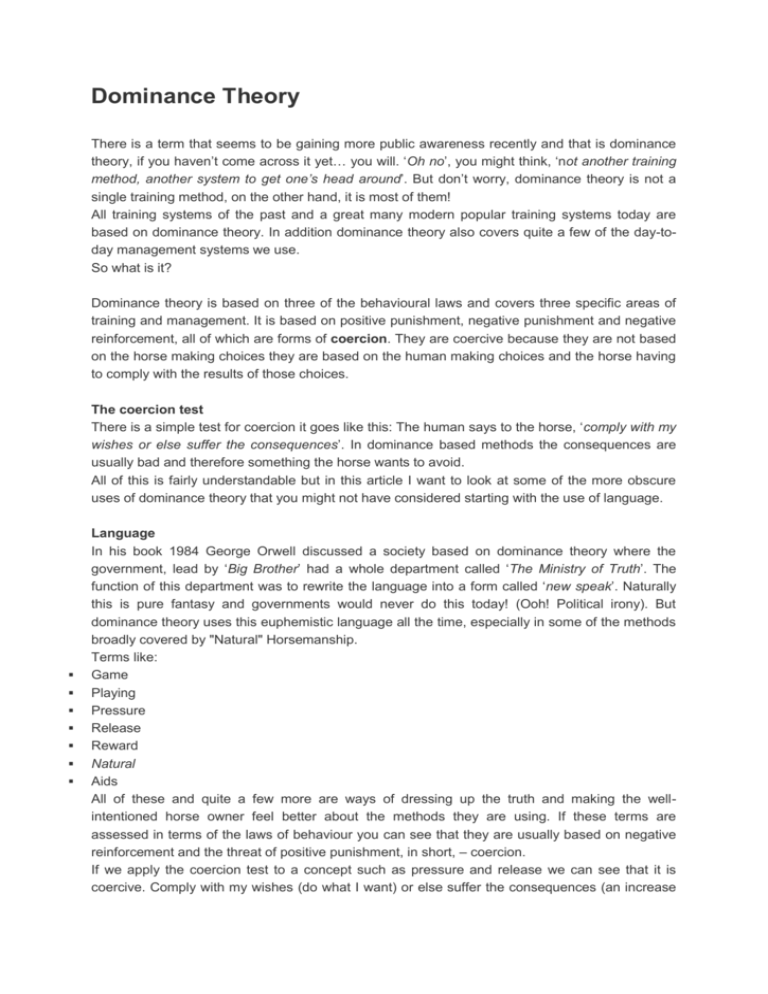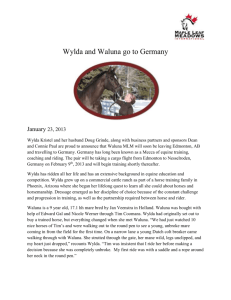Dominance theory is all about loss of choice.
advertisement

Dominance Theory There is a term that seems to be gaining more public awareness recently and that is dominance theory, if you haven’t come across it yet… you will. ‘Oh no’, you might think, ‘not another training method, another system to get one’s head around’. But don’t worry, dominance theory is not a single training method, on the other hand, it is most of them! All training systems of the past and a great many modern popular training systems today are based on dominance theory. In addition dominance theory also covers quite a few of the day-today management systems we use. So what is it? Dominance theory is based on three of the behavioural laws and covers three specific areas of training and management. It is based on positive punishment, negative punishment and negative reinforcement, all of which are forms of coercion. They are coercive because they are not based on the horse making choices they are based on the human making choices and the horse having to comply with the results of those choices. The coercion test There is a simple test for coercion it goes like this: The human says to the horse, ‘comply with my wishes or else suffer the consequences’. In dominance based methods the consequences are usually bad and therefore something the horse wants to avoid. All of this is fairly understandable but in this article I want to look at some of the more obscure uses of dominance theory that you might not have considered starting with the use of language. Language In his book 1984 George Orwell discussed a society based on dominance theory where the government, lead by ‘Big Brother’ had a whole department called ‘The Ministry of Truth’. The function of this department was to rewrite the language into a form called ‘new speak’. Naturally this is pure fantasy and governments would never do this today! (Ooh! Political irony). But dominance theory uses this euphemistic language all the time, especially in some of the methods broadly covered by "Natural" Horsemanship. Terms like: Game Playing Pressure Release Reward Natural Aids All of these and quite a few more are ways of dressing up the truth and making the wellintentioned horse owner feel better about the methods they are using. If these terms are assessed in terms of the laws of behaviour you can see that they are usually based on negative reinforcement and the threat of positive punishment, in short, – coercion. If we apply the coercion test to a concept such as pressure and release we can see that it is coercive. Comply with my wishes (do what I want) or else suffer the consequences (an increase in pressure). The decision to perform the exercise in the first place is entirely the choice of the human; who in this case is the coercer. The only choice given to the horse is to comply, thus making the horse the coerced. If you use coercion you are acting in a dominant way and thus are using dominance theory. The confusion here is caused by terms that appear ‘good’. The horse owner is told this is ‘playing games’ with their horse or that release is a fantastic reward and that by doing this you are behaving in a natural way. Often this is explained as how horses behave with each other therefore this is the horse’s natural behaviour. Which means that the horse will see us as another horse, a herd leader, or another member of the herd and because of this, the horse will want to do what we want out of respect for us and our status within the herd. In other words we are dominant. This all part of the new-speak used by 'natural' horsemanship to justify dominance. Really it is just the same old, – same old thing. The traditional world of training is almost more ‘honest’ than modern new-speak because the idea of dominance is not covered up, indeed, it is actually the aim of the entire process. The traditional world is based on ‘utility’ or the idea that the horse has a function – a job to do. Most of this thinking comes from the military world. A horse is expected to start, stop, turn right and left at the desired pace when the human rider decides that is what they want to do. This type of thinking sees the horse as a machine. There is very little acknowledgement that the horse has any say in or can think for itself at all. The modern version of this is the horse that is little more than a piece of sports equipment. Even though the horse will receive all the care attention and resources it needs, it will receive these only while it can do its job. These horses are disposed of when they are no longer able to fulfil their function. Horses that live like this are thus completely dominated by humans. One last example of dominance theory that is not connected with the training of the horse, lies in what I call the anthropomorphic model. This model is based on the law of negative punishment, it is usually associated with two things, 1. A loss of choice and 2. the environment in which the horse must live. For many people this is the most confusing aspect of all dominance theory because it is based around misguided feelings of benevolent care for the horse. The most common examples of this are the big four assumptions of housing, clothing, shoes and diet. Taking them in order: Housing This is the idea that a horse needs to live in a stable to keep it warm cosy and protected. The loss of freedom here is the loss of the herd and the company of other horses. More importantly for the horse, it is the loss of the emotion of safety. Obviously this is an issue of the environment and it is inescapable. The horse is completely at the mercy of the human until it is released by the human. This is called an environment of enforced negative punishment. Enforced negative punishment usually has one consequence:- depression. Clothing The arguments for clothing a horse are broadly the same as those for housing the horse, it is done for the animals protection and well-being. The loss of freedom here is the loss of the ability to regulate its own temperature a vital element in the regulation of the immune system. Once again the horse is at the mercy of the beliefs of the human and this is an environment of enforced negative punishment. Shoes Most people who shoe horses make an argument that the shoe protects the horses hoof from wear and tear. As this is a book length subject in itself, I won’t go into the arguments, but once again shoes create an environment of enforced negative punishment, Freedom is lost through the horse’s ability to interact with the environment and the whole thing is forced on the horse by its human. Diet Another book length issue but many people base the diet the their horse must eat on their own feelings and their own perception of food. The freedom lost here is the freedom to obtain food from the environment as it has evolved to do. Horses are forced to consume a diet (however bizarre) decided for them by human beings. Human-like diets are frequently based on cereal carbohydrates and sugar and a mis-perception that horses need to eat to refuel, this is backed up with all kinds of quasi-scientific information about calories, GI indexes, nutritional values and so on. The ironic results of all this is to create parallel instances of all the devastating health problems that are currently plaguing the human population. So this, in outline, is the all-pervasive idea of dominance theory. The essence of all of the situations I’ve discussed are summed up in one statement: Dominance theory is all about loss of choice. Training methods that are rooted in dominance theory are based only on choices made by the human. Negative punishment environments are all about loss of choice for the horse. It is true that in some training methods an apparent choice is given to the horse to do the right thing, but the consequences of not doing the right thing are always negative. The choice is effectively between something bad and something worse. Fortunately… There are new training methods and management systems that are based on positive choices for horses, in which the consequence of doing the right thing is always a reward. These are based on the fourth law of behaviour, the law of positive reinforcement where horses gain a reward for doing the right thing and not a punishment for doing the wrong thing. Just like dominance theory methods they cover both training and environment. In training they are based on emotions such as satisfaction and enthusiasm, they actively reward imagination and problem solving. In the management environment they are based on the long term health and well-being of the horse. Horses enjoy the freedom of life in a herd and the company of other horses, freedom of shelter, freedom of interaction with the environment. Horses never have to comply with the demands of the human, they never bring to a training session emotional baggage such as depression, fear and learned helplessness. I believe that this philosophy is the way of the future for horses and humans. I call it 21st Century Horse Keeping. [Article by Mark Hanson – EquiStyle source Donald Newe]






